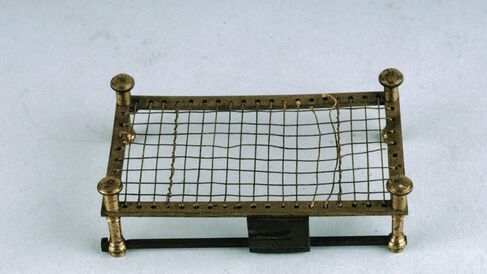Frog-plates

Early microscopists seized on frogs as objects of study both for their anatomical similarity to humans and their translucent skin. But without the benefits of electric lighting, 18th-century microscopes struggled to adequately illuminate their subjects. George Adams and Johann Nathanael Lieberkühn devised solutions to practical problems of vivisection, including of illumination, with their tables for displaying 'prepared,' living frog specimens. Technical advances of this kind facilitated new ways of seeing and understanding frogs' bodies.
Whipple Museum object Wh.1230 may look like a bed, but it's not one that any frog would like to find itself sleeping in. George Adams Sr., a London instrument maker and microscopist, devised this 'frog-plate' to support, immobilize, and display the vivisected bodies of frogs under a microscope. In the early 18th century, the microscope was a recent invention, as our microscopessection shows, and its emergence enabled a new approach to studies of the animal body. Though natural historians had long recorded the behaviors, qualities, and emblematic meanings of frogs, never had naturalists captured and subjected frogs to the type of violent scrutiny facilitated by Adams' slide.
Read more:
Henry Schmidt, 'Frog-plates: Adams and Lieberkuhn Preparation Slides', Explore Whipple Collections, Whipple Museum of the History of Science, University of Cambridge.
